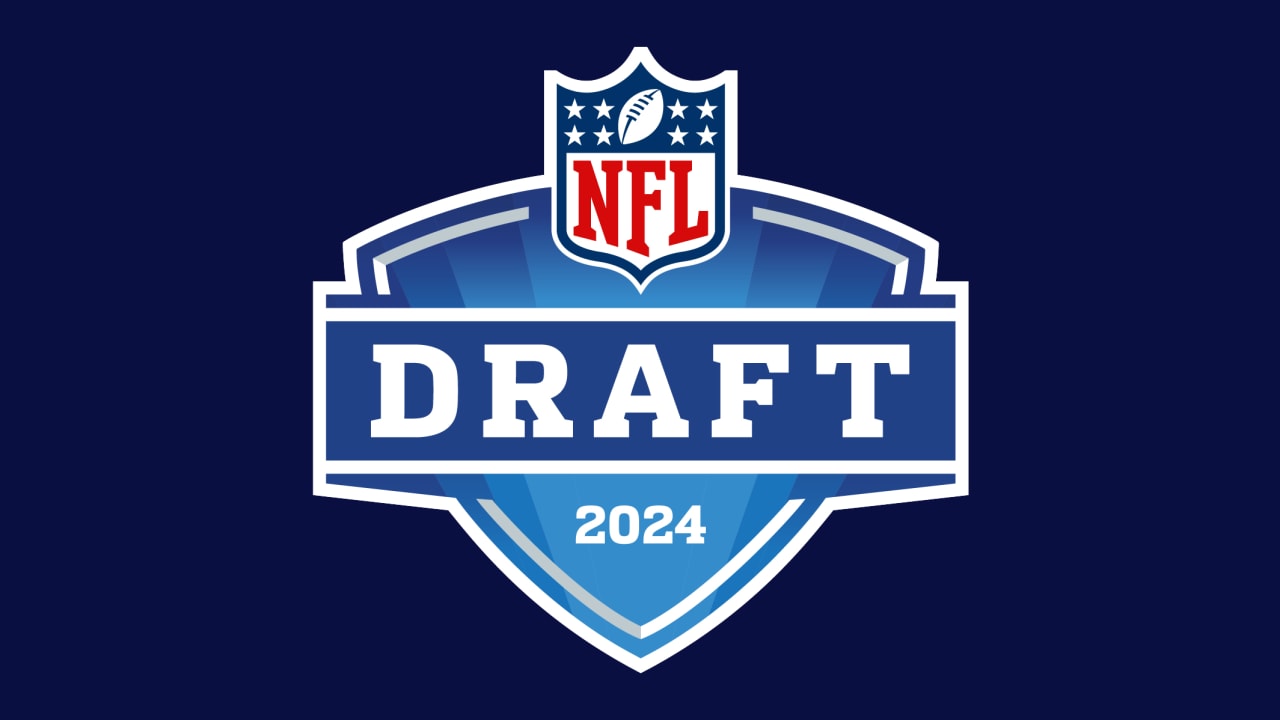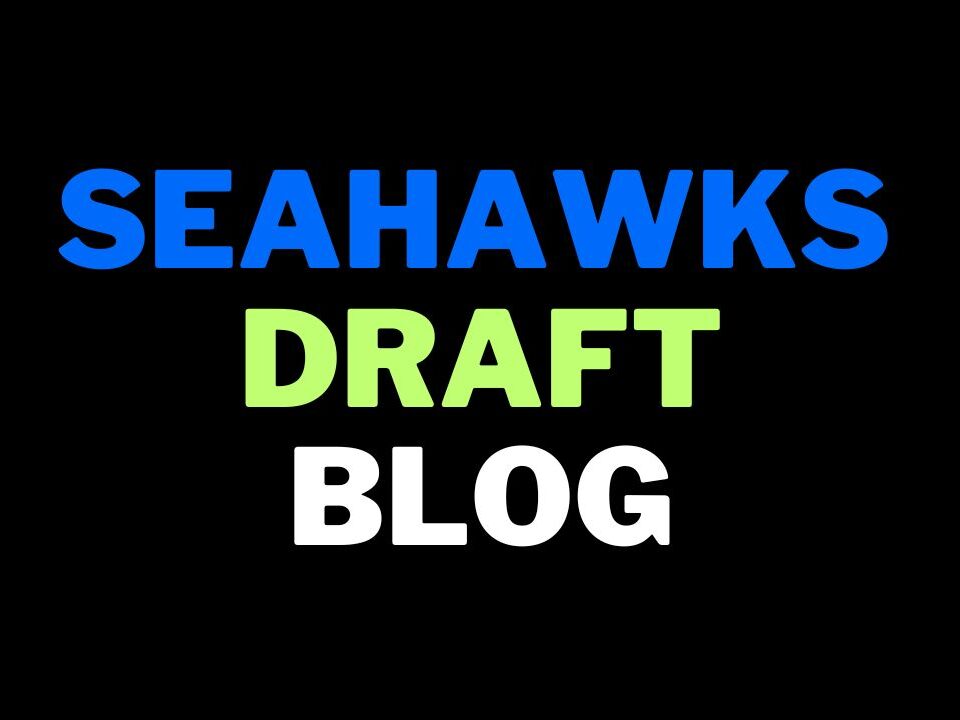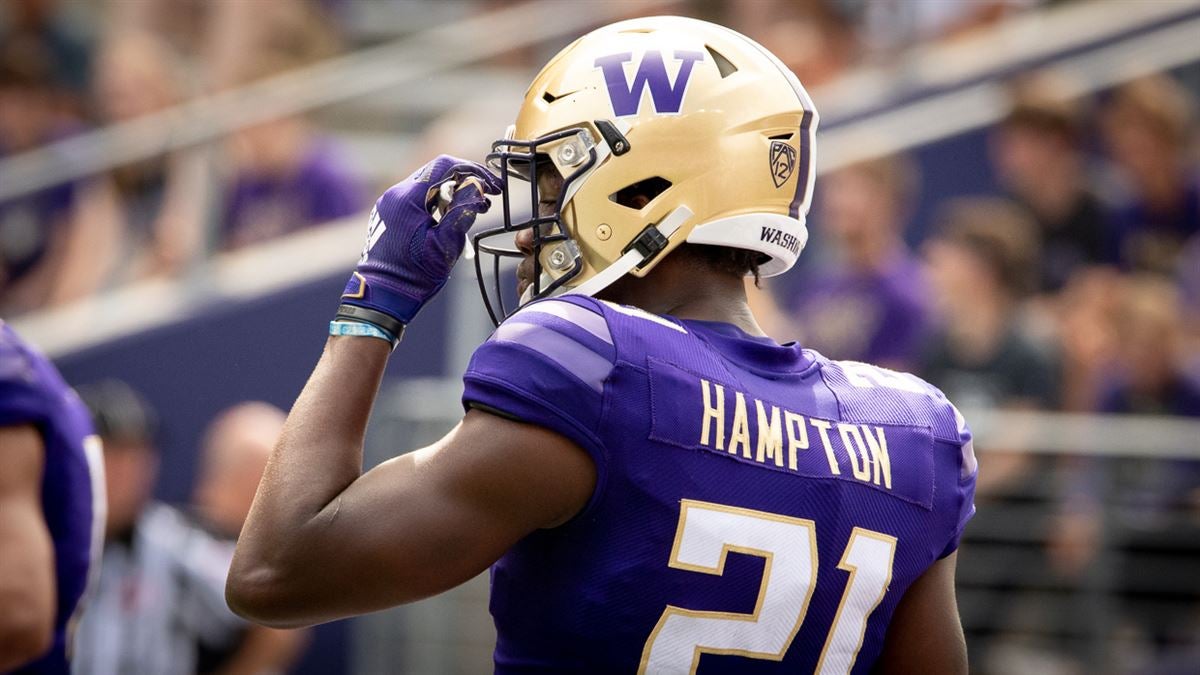
I think today’s mock is a realistic and fair projection for the Seahawks. I think it’d deserve a reasonable review if it happened, very much in the ‘they did the best they could’ category. However, I also think it’s nowhere near enough for this team to get to where it needs to be.
I was listening to Brian Nemhauser recently and he made a point I very much agree with. The Seahawks need a transformational draft. We’ve seen teams do it. Look at the Texans. They’ve gone from league laughing stock to contender in 12 months — all based on a highly successful 2023 draft class.
Other teams have also propelled themselves into contention with a strong draft. The Saints in 2017 drafted Marshon Lattimore, Ryan Ramczyk, Marcus Williams, Alvin Kamara, Alex Anzalone and Trey Hendrickson. They had a 39-15 regular season record over the next four seasons, dominated the NFC South and only missed out on a Super Bowl appearance due to incredible misfortune in playoff games against the Rams and Vikings.
I still think the Seahawks had good drafts in 2022 and 2023. I don’t think either has been transformational, though. The 2022 class flirted with it but key players didn’t take the big step forward we hoped in 2023. Now, it’s starting to look ‘decent’ rather than ‘transformational’.
Perhaps the hope is the new coaching staff can elevate both classes? If the argument is that Pete Carroll and his staff essentially held everyone back over the last two years, then it’s organisational malpractice that they didn’t move on from Carroll sooner. It’s weird to think now that they allowed Carroll the chance to be in control when the Wilson trade haul was used, then fired him immediately after the resources were spent.
Admittedly, having a transformational draft isn’t easy — otherwise every non-contender would do it. Yet the Seahawks are going to have to have one of these classes — as they did in the 2010-12 period every year — to propel themselves out of middling franchise status.
The draft I’ve projected below isn’t transformational. It won’t tilt the field in Seattle’s favour in the NFC West. It’ll be a good draft and we’ll be able to say it deserves a thumbs up. They need more than that though. Somehow, if we want this team to be great again, they’re going to have to find a way to do something special in a draft. Otherwise they’ll remain stuck in the middle ground of the NFL, with the best case scenario being a ‘make up the numbers’ playoff appearance.
It’s a full two-round projection below with five trades included. I’ve pitched some different scenarios here that I think are quite interesting and not that unrealistic. I’ve given my reasoning on the trades and thoughts on Seattle’s picks below. Let me know what you think in the comments section.
Round one
#1 Chicago (v/CAR) — Caleb Williams (QB, USC)
It’s been a foregone conclusion for a long time that Williams would be the #1 pick.
#2 Washington — Jayden Daniels (QB, LSU)
For me, he’s the clear #2 quarterback on the board.
#3 New England — Drake Maye -(QB, North Carolina)
I think they could easily trade out of this spot, with Eliot Wolf targeting an offensive lineman with the first pick instead of a quarterback.
TRADE #4 Denver (v/ARI) — JJ McCarthy (QB, Michigan)
We all assume this will be Minnesota’s move — but what if they have a different plan? Instead, the Broncos are the aggressor.
#5 LA Chargers — Marvin Harrison Jr (WR, Ohio State)
For all the talk of O-line, they need a receiver and are perfectly placed to land a potential star.
#6 New York Giants — Rome Odunze (WR, Washington)
Tony Pauline mentioned this week that some teams worry about Malik Nabers going to a big-city team and have Odunze rated above him as a consequence.
#7 Tennessee — Malik Nabers (WR, LSU)
Everyone says they’ll go O-line here. Brian Callahan is on the record as saying the modern NFL relies on dynamic quarterback and receiver play. He’ll trust his dad to put together a functioning offensive line. Remember when everyone thought the Bengals, with Callahan as OC, should take a tackle and they took a dynamic LSU receiver instead? That worked out OK.
#8 Atlanta — Dallas Turner (DE, Alabama)
I think Turner’s tape is massively underwhelming but there’s no doubt he’s a physical specimen.
#9 Chicago — Troy Fautanu (T, Washington)
I think he’s the best left tackle in the draft and teams may well agree.
#10 NY Jets — Brock Bowers (TE, Georgia)
They’re in win-now mode and take another dynamic weapon.
#11 Minnesota — Byron Murphy (DT, Texas)
The Vikings don’t trade up — yet — and instead stay right here and take Byron Murphy to be a dynamic interior rusher.
TRADE #12 Minnesota (v/ARI, DEN) — Michael Penix Jr (QB, Washington)
Now the Vikings trade up — right in front of the Raiders. The Cardinals move down again, accumulating future first round picks from both Denver and Minnesota. In this scenario, the Vikings’ plan wasn’t to use their picks to trade into the top-five. It was to make sure they get Murphy and a quarterback in an attempt to contend ASAP.
#13 Las Vegas — Taliese Fuaga (T, Oregon State)
After missing out on Penix Jr, they settle for a Raiders’ style O-liner.
#14 New Orleans — Joe Alt (T, Notre Dame)
Everyone thinks he’ll be the first O-liner taken but he just reminds me of Mike McGlinchey.
#15 Indianapolis — Quinyon Mitchell (CB, Toledo)
The Colts have a need at cornerback and Mitchell’s had an outstanding draft process.
TRADE #16 Philadelphia (v/SEA) — Terrion Arnold (CB, Alabama)
With the first cornerback coming off the board at #15, the Eagles don’t hang about. They give the Seahawks a fourth rounder (#120), a fifth rounder (#161) and swap a second round pick in 2025 for a fourth rounder to move up.
#17 Jacksonville — Brian Thomas Jr (WR, LSU)
After losing Calvin Ridley, the Jaguars get a replacement.
#18 Cincinnati — JC Latham (T, Alabama)
The Bengals love size on their offensive line. Latham can play guard in year one, then kick outside to right tackle in year two.
#19 LA Rams — Chop Robinson (DE, Penn State)
The Rams get a steal with Robinson’s dynamic get-off and remarkable edge-bending ability. He’s wildly underrated with special qualities.
#20 Pittsburgh — Amarius Mims (T, Alabama)
There’s a feeling the incredible looking Mims won’t get out of the top-20.
#21 Miami — Laiatu Latu (DE, UCLA)
With injuries to their starters, the Dolphins might be prepared to tap into the value of taking Latu here.
#22 Seattle — Graham Barton (T/G/C, Duke)
The Seahawks have Steve Hutchinson as an advisor in their draft room. Hutchinson was 6-5, 315lbs, had shorter arms (32 1/8 inches) and played with an edge. He might see a bit of himself in Barton, who’s 6-5, 313lbs, has 32 7/8 inch arms and plays with an edge.
#23 Arizona (v/MIN, HOU, CLE) — Jared Verse (DE, Florida State)
After trading down 19 spots, they still get Verse and a haul of picks. What a draft this would be for the Cardinals.
#24 Dallas — Olu Fashanu (T, Penn State)
I think he might last longer than people think.
#25 Green Bay — Tyler Guyton (T, Oklahoma)
They need to add to the tackle position and Guyton can play on the left or right side of the line.
TRADE #26 Washington (v/TB) — Jordan Morgan (T/G, Arizona)
The Commanders see the left tackle options running out so move up in a deal with the Buccs to get Morgan.
#27 Arizona (v/HOU) — Nate Wiggins (CB, Clemson)
The Cardinals continue to build their defense up with a fast, talented cornerback.
#28 Buffalo — Adonai Mitchell (WR, Texas)
The Bills replace Stefon Diggs without needing to trade up.
#29 Detroit — Kamari Lassiter (CB, Georgia)
I think people are sleeping way too much on Lassiter, who I liked a lot on tape and in combine drills.
#30 Baltimore — Ladd McKonkey (WR, Georgia)
The Ravens take a dynamic outside receiver who is Mr. Reliable with excellent upside.
#31 San Francisco — Jer’Zhan Newton (DT, Illinois)
The 49ers continue to use first round picks on their defensive line.
#32 Kansas City — Cooper DeJean (CB, Iowa)
The Chiefs generally draft for top-tier physical traits.
Round two
TRADE #33 Tennessee (v/CAR) — Roger Rosengarten (T, Washington)
#34 New England — Kingsley Suamataia (T, BYU)
#35 Arizona — Ricky Pearsall (WR, Florida)
#36 Tampa Bay (v/WAS) — Jackson Powers-Johnson (C, Oregon)
#37 LA Chargers — Darius Robinson (DE, Missouri)
#38 Carolina (v/TEN) — Xavier Worthy (WR, Texas)
#39 Carolina (v/NYG) — Ben Sinnott (TE, Kansas State)
#40 Washington (v/CHI) — Malachi Corley (WR, Western Kentucky)
#41 Green Bay (v/NYJ) — Junior Colson (LB, Michigan)
#42 Houston (v/MIN) — Kool-aid McKinstry (CB, Alabama)
#43 Atlanta — T.J. Tampa (CB, Iowa State)
#44 Las Vegas — Troy Franklin (WR, Oregon)
#45 New Orleans (v/DEN) — Keon Coleman (WR, Florida State)
#46 Indianapolis — Braden Fiske (DT, Florida State)
#47 NY Giants (v/SEA) — Mike Sainristil (CB, Michigan)
#48 Jacksonville — Michael Hall Jr (DT, Ohio State)
#49 Cincinnati — T’Vondre Sweat (DT, Texas)
#50 Philadelphia (v/NO) — Javon Bullard (S, Georgia)
#51 Pittsburgh — Roman Wilson (WR, Michigan)
#52 LA Rams — Spencer Rattler (QB, South Carolina)
#53 Philadelphia — Xavier Legette (WR, South Carolina)
#54 Cleveland — Edgerrin Cooper (LB, Mississippi State)
#55 Miami — Cooper Beebe (G, Kansas State)
#56 Dallas — Zach Frazier (C, West Virginia)
#57 Tampa Bay — Payton Wilson (LB, NC State)
#58 Green Bay — Cole Bishop (S, Utah)
#59 Houston — J’Tavion Sanders (TE, Texas)
#60 Buffalo — Tyler Nubin (S, Minnesota)
#61 Detroit — Ja’Lynn Polk (WR, Washington)
#62 Baltimore — Dadrion Taylor-Demerson (S, Texas Tech)
#63 San Francisco — Christian Haynes (G, Connecticut)
#64 Kansas City — Jalen McMillan (WR, Washington)
Players not included in the two-round mock
Bo Nix (QB, Oregon)
Zak Zinter (G, Michigan)
Theo Johnson (TE, Penn State)
Ruke Orhorhoro (DT, Clemson)
Bralen Trice (DE, Washington)
Chris Braswell (DE, Alabama)
Brandon Coleman (T, TCU)
Jermaine Burton (WR, Alabama)
Trey Benson (RB, Florida State)
Jaylen Wright (RB, Tennessee)
The trades explained
Denver trades #12 plus their 2025 & 2026 first rounders to Arizona for the #4 pick
The Broncos make their move to get J.J. McCarthy, giving up a haul of picks to do so. Sean Payton has never been afraid to use future picks to get the guy he wants.
Minnesota trades #23, #108 and their 2025 first rounder and 2026 second rounder to Arizona for the #11 pick
The Cardinals come out of this mock in possession of Denver and Minnesota’s first round picks next year, plus Denver’s first and Minnesota’s second in 2026. They are still able to select Jared Verse and Nate Wiggins in round one. They win the 2024 draft.
Philadelphia trades #22, #120, #161 and a 2025 second rounder to Seattle for the #16 pick and a 2025 fourth rounder
The Eagles need youth and talent at cornerback and after seeing Quinyon Mitchell leave the board at #15, they don’t hang around and make a move to get Terrion Arnold.
Washington trades #34 and #78 to Tampa Bay for the #26 pick
The Commanders need a left tackle and find a willing trade partner in the Buccs, allowing them to move up for Jordan Morgan.
Tennessee trades #38, #106 and #182 to Carolina for the #33 pick
The Titans work a deal with the Panthers before round two kicks off, enabling them to jump ahead of New England so they can select Roger Rosengarten (who has the ability to play left or right tackle).
Thoughts on the Seahawks’ first round pick
I continue to think if Troy Fautanu and Taliese Fuaga are off the board at #16, the Seahawks will trade down. That was the case in this projection and I think this scenario is very likely.
Ideally they’d get a big offer that includes an additional day-two pick, preferably a second rounder. However, I think teams will really value their second round picks in this class and will be wary to give them away. Plus, trade-up candidates such as Dallas, Green Bay and Buffalo all address needs without having to trade up in this mock.
I have the Seahawks doing a deal with the Eagles to get a fourth and fifth round pick this year, plus a swap of picks in 2025 (Seattle gets Philly’s second rounder, the Eagles get the Seahawks’ fourth rounder). It’s fair value per the trade chart, given the 2025 second rounder will carry the value of a third. The Seahawks accept their fate in this draft, get something of real value for next year and trade down into a range where they can still get a player they really like in round one.
The Eagles are very much in ‘win right now’ mode and might be prepared to be aggressive, as they have been in the past.
Graham Barton is plugged in at left guard immediately, with the Seahawks seeing value in his ability to potentially play center or tackle too. His talent is worthy of the 22nd pick — so it’s a nice case of need meeting value.
This would leave the Seahawks with a third rounder (#81), three fourth rounders (#102, #118, #120), a fifth rounder (#161) two sixth rounders (#179, #192) and a seventh rounder (#235).
They’d have the option to use all of those picks — and there will be good options through to round four — or they could use this stock to move up from #81 if a player they really like drops into range. Or, they could package two fourth’s to get back into round three.
Seahawks seven round mock
#22 (R1) Graham Barton (T/G/C, Duke)
As discussed above, he’d be a plug-and-play offensive lineman drafted in a range that matches need with talent.
Seahawks trade #120 to the New York Giants to move from #81 to #70
#70 (R3) Bralen Trice (DE, Washington)
Trice was sick prior to the combine, lost a ton of weight and performed poorly. His stock has dropped. The Seahawks might sense an opportunity to trade up and get excellent value. Trice had the same pass rush grade (per PFF) as Jared Verse (90.8) and he was well ahead of Dallas Turner (89.3). He led the NCAA in pressures (80) and hurries (53) in 2023, plus he was second for QB hits (19). This is an opportunity to add a dynamic talent at a value range.
#102 (R4) Dominique Hampton (S, Washington)
I’m not a Husky fan before anyone asks — but tapping into a team that reached the National Championship game isn’t a bad thing. Hampton is a dynamic athlete and a versatile safety who plays with toughness and discipline. He’d be an ideal fit in Macdonald’s defense.
#118 (R4) Ryan Flournoy (WR, SE Missouri State)
He shone at the Senior Bowl, gaining separation with ease in 1v1’s. He ran a 4.44 and jumped a 39.5 inch vertical. He also has massive 10 1/8 inch hands for a player who’s only 6-1 and 202lbs. Flournoy is well known for his high level of football character.
#161 (R5) Nathaniel Watson (LB, Mississippi State)
Macdonald says his defenders need to blitz. Nobody blitzes better than Watson, with 21 college sacks from linebacker. He has an old-school mentality, fits perfectly for the 3-4 defensive system and has quickness shown via a 1.59 10-yard split. Watson also called the plays on defense for Mississippi State.
#179 (R6) Jack Westover (TE, Washington)
Another Husky pick — but Westover was clutch in big moments during the 2023 season. The Seahawks need to add a tight end at some point and if they get this far without adding one, Westover would be a good option.
#192 (R6) Karsen Barnhart (G, Michigan)
The Seahawks met with him at Michigan’s pro-day. He has positional versatility, everyone on that Michigan line plays with toughness and he has some explosive ability (9-3 broad jump).
#235 (R7) Emani Bailey (RB, TCU)
He’s an ideal third-down back — capable of running crisp routes with soft hands. As a runner, he finishes and plays with aggression. He shone during the Senior Bowl game and should’ve been MVP.
Thoughts on the Seahawks’ seven rounder
It might not be the flashiest draft but if the Seahawks can’t fill the hole between #16 and #81 by trading down, this might be the type of class they end up with. There’s no guarantee better offers will be available to trade down.
Barton would fill a void at guard and could develop into an all-pro at his position — he has the talent to achieve it. Trice’s stock might’ve taken a hit after the combine but he was a regular impact player at UW and could be a third round steal, enabling the Seahawks to get a top-50 talent.
Hampton is a far better player than I think people realise and could be an immediate impact player, while Flournoy could easily be a nice receiver option for the future when Tyler Lockett eventually moves on. Watson has starter level potential while Westover, Barnhart and Bailey provide depth.
The addition of Trice could allow the Seahawks to save money by cutting Darrell Taylor or trading Dre’Mont Jones after June 1st to create cap room.
Again, it feels like a plausible projection and one that it’d be difficult to challenge if this is all they can get to trade down. Is a draft like this going to dramatically alter Seattle’s ability to be a contender, though? Sadly, I don’t think so.
Is there anything they can do differently to have a transformational draft?
I think there are two possible options. One, is to hit on a player so good that he completely transforms one side of the ball. Typically that only happens when you land a franchise quarterback or a true, elite pass rusher.
The other is to accumulate numerous picks in the first three rounds and hit on a lot of players in a big way. That would mean trading down and getting a great offer.
In this scenario, with five quarterbacks off the board by pick #12, the chances of getting a franchise-changing quarterback are remote. The available player who I do think could have difference making ability is Chop Robinson. There is legitimately some Micah Parsons to his game. His get-off is top-notch and his ability to bend and straighten off the edge is incredible. If you stick and pick at #16, take him, and he becomes anything close to Parsons — that could be transformational. It’s good to see the Seahawks arranged an official-30 visit with Robinson.
Can they get a great offer to move down? Sure. But as noted in the mock — this isn’t the kind of class where teams are likely to be desperate to relieve themselves of day two picks. Plus, the Seahawks won’t be the only team looking to move down. That means, perhaps, there’s a case to be made for sticking and picking at #16 if a player like Robinson is available — rolling the dice on a high upside talent with blue-chip credentials, rather than just trying to have the kind of ‘decent’ draft I’ve projected above.



/cdn.vox-cdn.com/uploads/chorus_image/image/73261745/1779985509.0.jpg)



